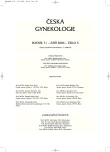Infant Mortality due to Birth Defects in the Czech Republic in 1994–2004
Authors:
A. Šípek 1,2; V. Gregor 3,4; J. Horáček 3,4; D. Mašátová 5
Authors‘ workplace:
Ústav pro péči o matku a dítě, Praha, ředitel doc. MUDr. J. Feyereisl, CSc.
1; Institut postgraduálního vzdělávání ve zdravotnictví, Praha, Katedra gyn. -por., ředitel MUDr. A. Malina
Ph. D., MBA
2; Oddělení lékařské genetiky, Fakultní Thomayerova nemocnice, Praha, ředitel MUDr. P. Malý
3; Institut postgraduálního vzdělávání ve zdravotnictví, Praha, Katedra lékařské genetiky, ředitel
MUDr. A. Malina, Ph. D., MBA
4; Ústav zdravotnických informací a statistiky České republiky, Praha, ředitelka Mgr. V. Mazánková
5
Published in:
Ceska Gynekol 2006; 71(5): 380-388
Category:
Original Article
Overview
Aim and type of study:
A retrospective data study with an analysis of pre- and postnatal occurrence of selected types of birth defects in the Czech Republic during 1994 to 2004 period. An analysis of infant mortality rate in children with selected types of birth defects during their first year of life is described.
Methodology:
Data on prenatal diagnostics were obtained from particular departments of medical genetics. Data on birth defects incidences were obtained from National Health registers - Institute of Health Information and Statistics (National Register of Congenital Anomalies and National Newborns Register) from the 1996–2004 period were used. A case analysis of incidences of 14 types of pre- and postnatally diagnosed birth defects was performed for the period 1994–2004. In postnatally diagnosed cases, an analysis of survival and extinction of particular types of defects during the first year of life was also performed.
Results:
During 1994–2004, there were 1 030 069 children born in the Czech Republic. Including prenatally diagnosed cases, we registered 305 cases of anencephaly, 454 spina bifida, 156 encephalocele, 528 cases of congenital hydrocephalus, 304 omphalocele and 302 cases of gastroschisis, 241 oesophageal defects, 302 anorectal malformations, 312 cases of diaphragmatic hernia, 518 renal agenesis/hypoplasia cases, 529 cases of cystic kidneys and 1764 Down syndrome cases. Secondary prevention rate was high in neural tube defects (61–100 %), abdominal wall defects (60–79 %) and Down syndrome (63 %). In operable defects, a first-year survival was lowest in congenital hydrocephalus (63 %) and neural tube defects -excluding anencephaly - (82 %). In abdominal wall defects, diaphragmatic hernia, oesophageal and anorectal malformations, the survival rate was, however, 76–91 % of children.
Conclusions:
Birth defects present a major contribution to infant mortality and morbidity. Prematurity in a combination with a birth defect prolongs inpatient days and increases a need of a total parenteral feeding in a newborn and it also makes a worse prognosis for the infants with birth defects. An improvement of prenatal diagnostics with an early detection of the most severe types along with the associate ones could decrease incidences of such cases. A progress in surgical techniques and a special neonatal and infant intensive health care would also contribute an improvement of survival.
Key words:
birth defect, anencephaly, spina bifida, encephalocele, congenital hydrocephalus, omphalocele, gastroschisis, oesophageal defects, anorectal malformations, diaphragmatic hernia, renal agenesis/ hypoplasia, cystic kidneys, Down syndrome
Labels
Paediatric gynaecology Gynaecology and obstetrics Reproduction medicineArticle was published in
Czech Gynaecology

2006 Issue 5
Most read in this issue
- Pregnancy after Laparoscopic Myomectomy – Long-term Follow up
- Delayed Interval Delivery in Twins Pregnancy - The Case Report
- OSCAR (One-Stop Clinic for Assessment of Fetal Risk): Our Experience with First Trimester Screening for Chromosomal Abnormalities
- Insertion-deletion Polymorphism in the Gene for Angiotensin – Converning Enzyme (I/D ACE) in Pregnant Women with Gestational Diabetes
